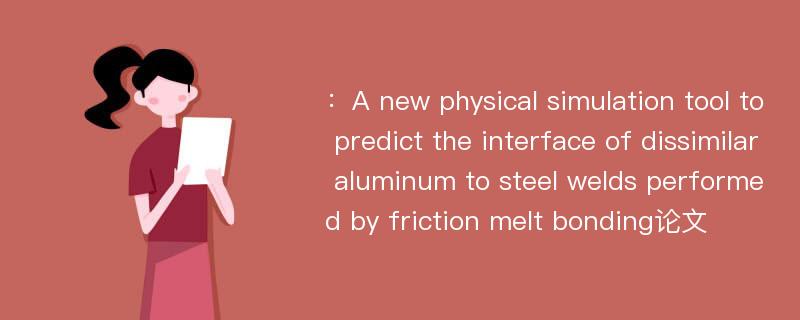
本文主要研究内容
作者(2019)在《A new physical simulation tool to predict the interface of dissimilar aluminum to steel welds performed by friction melt bonding》一文中研究指出:Optimization of the intermetallic layer thickness and the suppression of interfacial defects are key elements to improve the load bearing capacity of dissimilar joints. However, till date we do not have a systematic tool to investigate the dissimilar joints and the intermetallic properties produced by a welding condition. Friction Melt Bonding(FMB) is a recently developed technique for joining dissimilar metals that also does not exempt to these challenges. The FMB of DP980 and Al6061-T6 was investigated using a new physical simulation tool, based on Gleeble thermo-mechanical simulator, to understand the effect of individual parameter on the intermetallic formation. The proposed method demonstrates its capability in reproducing the intermetallic characteristics, including the thickness of intermetallic bonding layer,the morphology and texture of its constituents(Fe2Al5 and Fe4Al13), as well as their nanohardness and reduced modulus. The advantages of physical simulation tool can enable novel developing routes for the development of dissimilar metal joining processes and facilitate to reach the requiring load bearing capacity of the joints.
Abstract
Optimization of the intermetallic layer thickness and the suppression of interfacial defects are key elements to improve the load bearing capacity of dissimilar joints. However, till date we do not have a systematic tool to investigate the dissimilar joints and the intermetallic properties produced by a welding condition. Friction Melt Bonding(FMB) is a recently developed technique for joining dissimilar metals that also does not exempt to these challenges. The FMB of DP980 and Al6061-T6 was investigated using a new physical simulation tool, based on Gleeble thermo-mechanical simulator, to understand the effect of individual parameter on the intermetallic formation. The proposed method demonstrates its capability in reproducing the intermetallic characteristics, including the thickness of intermetallic bonding layer,the morphology and texture of its constituents(Fe2Al5 and Fe4Al13), as well as their nanohardness and reduced modulus. The advantages of physical simulation tool can enable novel developing routes for the development of dissimilar metal joining processes and facilitate to reach the requiring load bearing capacity of the joints.
论文参考文献
论文详细介绍
论文作者分别是来自Journal of Materials Science & Technology的,发表于刊物Journal of Materials Science & Technology2019年09期论文,是一篇关于,Journal of Materials Science & Technology2019年09期论文的文章。本文可供学术参考使用,各位学者可以免费参考阅读下载,文章观点不代表本站观点,资料来自Journal of Materials Science & Technology2019年09期论文网站,若本站收录的文献无意侵犯了您的著作版权,请联系我们删除。
